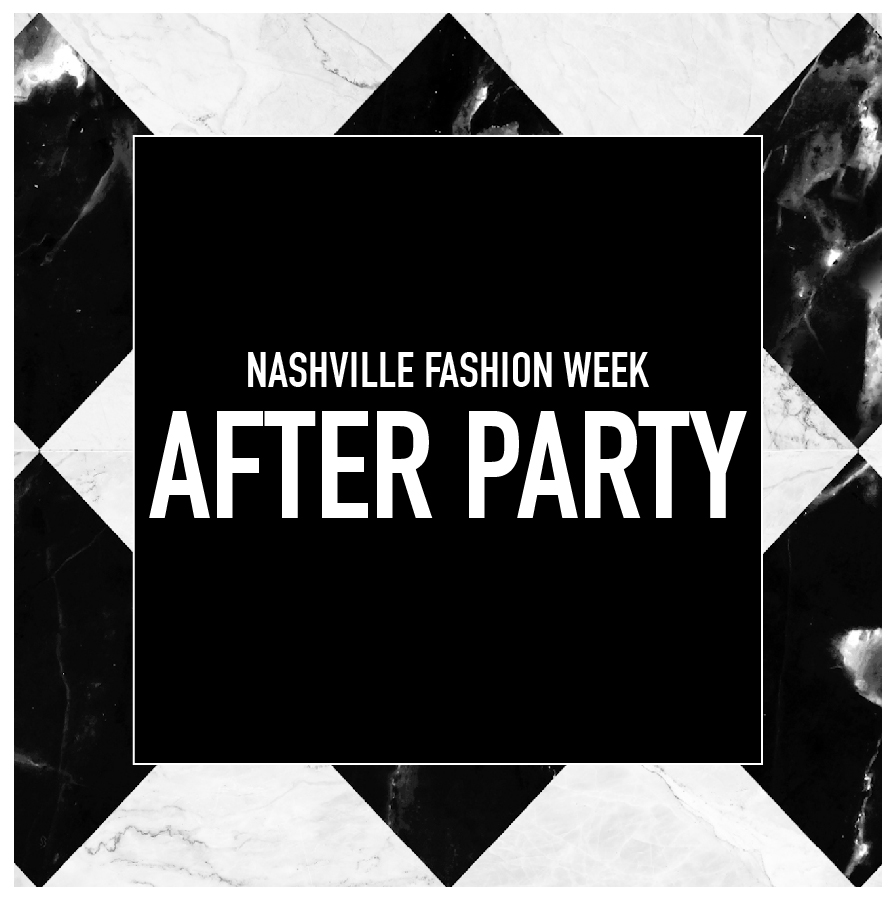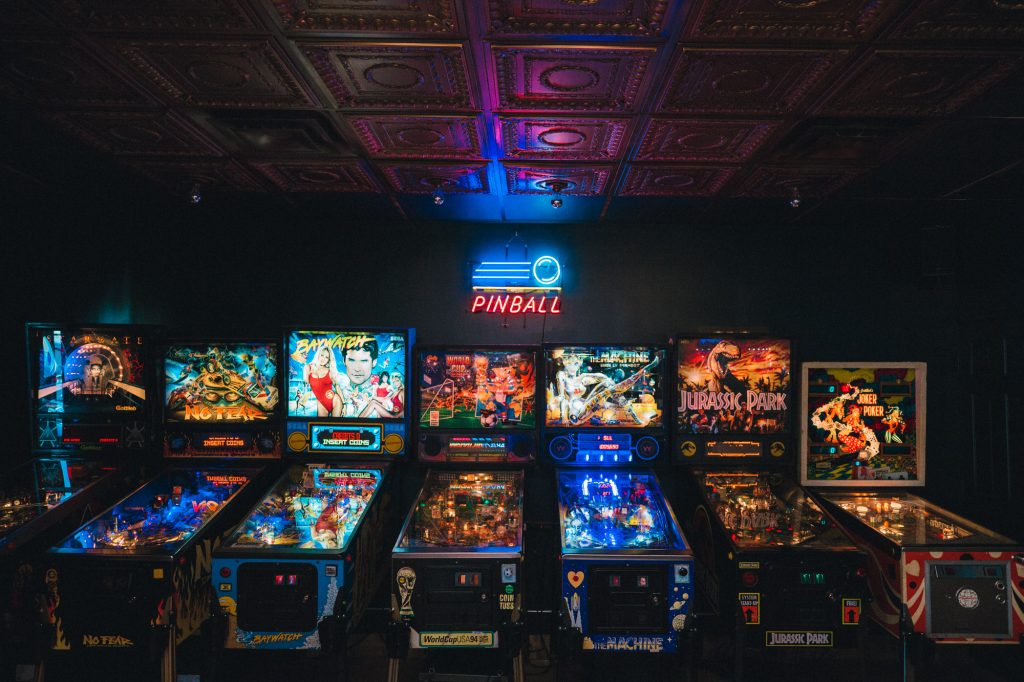
It consumes you. In a good way.
—Jack Danger, host of Dead Flip Pinball (from Under the Glass)
Pinball is like death: the end is inevitable. You might have such a supple wrist. You may have crazy flipper fingers. You could always get the replay. And still, your ball will, with complete and utter certainty, end up down the drain. The world record for longest pinball game stands at thirty hours—even that epic run by Wayne Johns (who, I assume, was in diapers?) had to come to a close.
Pinball is tactile, real, sensory. It’s analog action in a digital world. That physicality is part of what Scott Holdren and Seth Steele, co-owners of new East Nashville pinball bar No Quarter, find so appealing about the game. Over cups of coffee, surrounded by No Quarter’s pinball machines, Holdren (scoreboard initials DSH) explains the allure to me. “It’s not a screen. Not primarily a screen anyway. It’s something that you can bash around. I really like fixing things, and they’re constantly breaking. So it’s the perfect hobby for me.”
Holdren and Steele worked together in software development, but a few years back Holdren moved into a new office near Cannery Row that had a big, empty basement—and endless possibilities. Wood shop? Movie theater? Sex dungeon? To each their own, right? Holdren was considering buying a pinball machine when a Craigslist post made the decision for him. “The Game Galaxy down in Antioch was selling a Black Knight, which was my favorite machine growing up. I went down and bought it and brought it home and immediately broke it,” Holdren laughs.
Pinball machines are notoriously fickle and require constant maintenance, especially older games like Black Knight (made in 1980). And that’s if you know what you’re doing, which Holdren did not. “I plugged it in. You had to take it apart to move it, and when I put it back together, I plugged it in wrong and blew up all the circuitry.” Holdren shakes his head and smiles. “I had to then embark on a crash course in pinball repair. Something about getting that game going again just made me wanna get more machines. And Seth [Steele] caught the same bug.”
“I saw the fun he was having repairing games,” Steele (SEF on the high scores) recalls. “The idea of going down to the basement, working on something with my hands, and getting away from a screen for a while was really appealing.” Pinball’s randomness was also a breath of fresh air for Steele. “It’s just not preplanned. That ball can go anywhere. It’s real. And it’s pure chaos, really. Your goal is to control that chaos as best you can.”
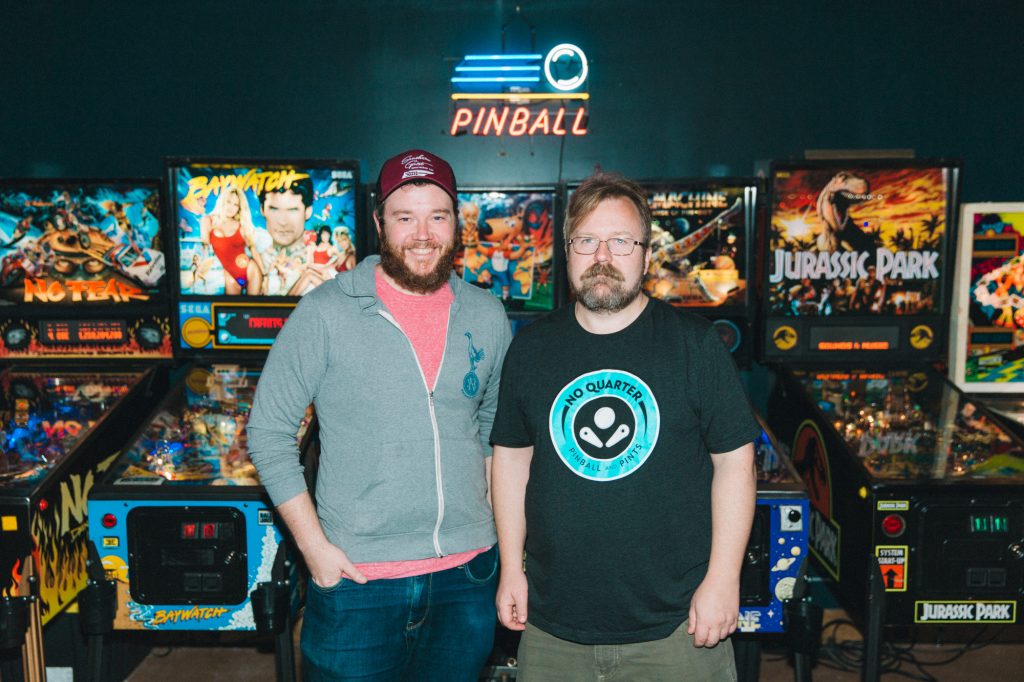
Steele picked up his own table, High Speed. An action-packed police chase! a game flyer exclaims. Steve Ritchie, one of pinball’s most acclaimed table architects, designed the game. He designed Black Knight, too, among many other countless titles. On High Speed, Ritchie claims, “It was based on a true story. I was actually chased by the cops at 146 mph in my 1979 Porsche 928.”
With High Speed, Steele was hooked. “I got one. And then one turned to twelve,” he grins. Twelve became a combined collection of more than forty tables. Naturally, they invited a few friends to the basement. “Once a month we’d have people come out, BYOB, play pinball all night. And we were getting fifty, sixty people. But it was just a private office space!” Steele chuckles. “When we started getting that many people, and people are having fun, we wanted to rent it out for private events. And it was like, ‘We gotta do something!’”
And so No Quarter arose on Main Street, a vision of chrome and neon and dot-matrix displays. A dozen tables make a tight semicircle in the front room, all facing a thoughtfully curated jukebox and a widescreen used to display tournament results and rankings. The guys show me around the rest of the place. There’s a bar, then a very purple room (the color was an accident) where folks can get a break from the noisy action.
The bar itself was rescued from Holland House after its abrupt closing. The No Quarter boys are proud to give the storied counter new life in a cozy home. “We spent so much time on this bar!” Holdren exclaims with glee. Steele grabs a small object from above the bar. There’s a friendly rivalry between Nashville and Memphis pinball players, and they face off in an annual tournament. “We lost last year,” Steele says with regret. “This is the loser’s trophy.” It’s a pewter toilet that only just fits a pinball.
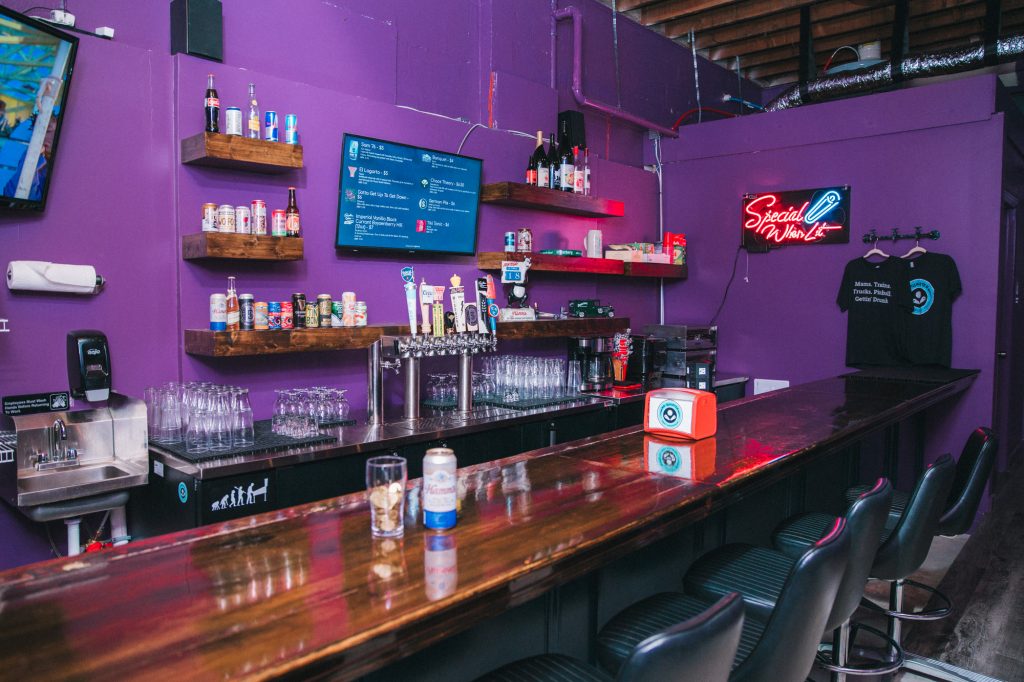
Over the years, the game of pinball has evolved dramatically. The combination of marbles, a spring-loaded launch apparatus, and an inclined plane was all it took to play the game through the late 19th and early 20th centuries. One hundred years later, pinball is nearly unrecognizable, but the core principle still applies: shoot a small ball through obstacles that rest on an angled surface, ensuring your inevitable plummet to the bottom. As opposed to drugs, coming down is the fun part.
When I visit a month and change after their opening, Steele and Holdren have a selection representing a history of pinball over the the last forty years. Joker Poker (1978), with scores in yellow monochrome on the backglass, sits right next to Jurassic Park (1993), a table that includes a dot-matrix display, music clips from the soundtrack, voice commands (“Shoot the raptor!”), and a gun-shaped auto-plunger that fires your ball to the top of the playfield.
Dedicated pinballers have not only a favorite table or two, but a preferred era, or production company, or designer. Holdren only plays Steve Ritchie games. But even the most casual players can have fond memories of particular tables. “There’s a nostalgia thing that kicks in for a lot of people,” Steele tells me. “They might’ve grown up playing it. Bride of Pinbot’s a big one. Our health inspector came in, and she remembers playing Bride of Pinbot when she was working concession stands as a teenager. And she walked in and she was just like—” As if on cue, the Bride of Pinbot suddenly comes alive with a woman’s devilish laugh and a vocoder-ized, computer-y voice murmuring unintelligibly. Laser sounds. Lights flashing. One of the best-loved games of all time is trying to draw us in.
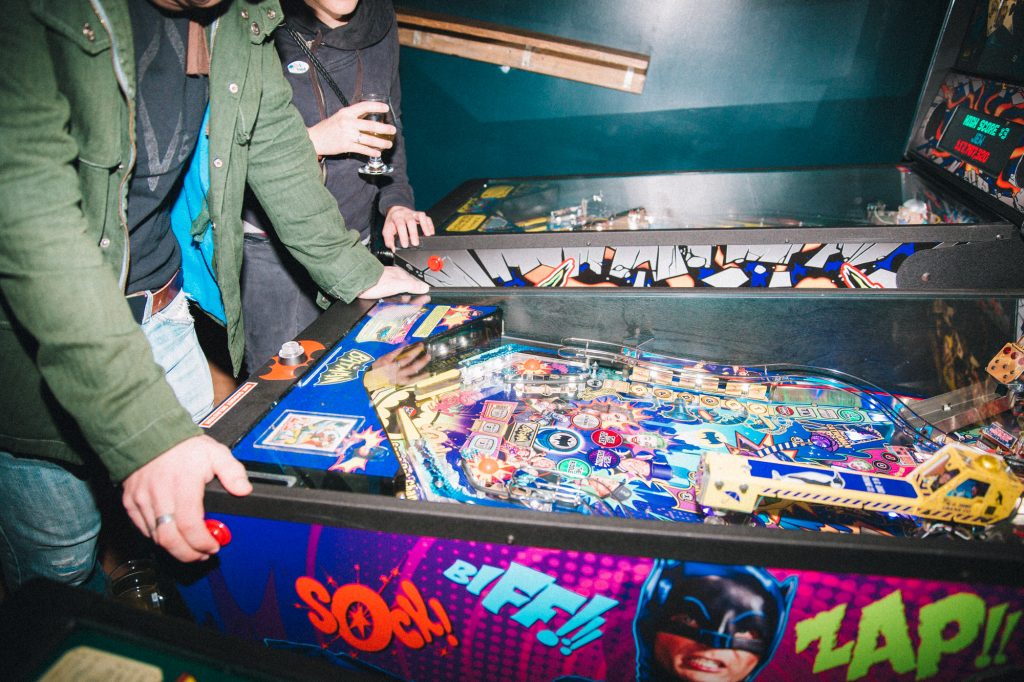
Of course, teenagers aren’t the only ones who play, Steele reminds me. “Another thing I love about pinball is all these different people from different lifestyles. It’s like all these subcultures blend together when you go to a pinball tournament. These are people you think wouldn’t typically be hanging out. The punk kid is hanging with the preppie kid. It just brings everybody together. The people-watching at events is pretty fascinating. You might have this seventy-year-old man playing against this fifteen-year-old girl—and she beats the crap out of him!”
No Quarter plans to rotate their tables, not only to provide a new experience but to have time and space for maintenance and repairs. I ask the guys about their biggest surprises in the life of their new business. “I thought the games were gonna break more,” replies Steele. “Really? I thought they were gonna break less!” Holdren counters, and they both laugh. Holdren continues. “It’s been ten to twenty hours a week, probably, making fixes. I hope it slows down, and I feel like we’re getting some things under control. But we’re talking about bringing another game over here, and I know the second we bring it over here, we’re gonna find fifty things wrong with it.”
Pinball companies (e.g. Stern, Bally, Williams, etc.) never made longevity a priority. A table might be in the corner of a bar or an arcade for a year or two, and then it’s time to upgrade to the newest model. “The plastics, they dry out and snap,” Holdren explains. “And some of the electronics, a lot of stuff overheats. These machines, they don’t seem like they were really built to last thirty years.”
“We get asked a lot about repairs,” Steele follows up. “We’re actually using our Twitter account purely to post a maintenance log. When we fix a game, or something breaks, we post on there.”
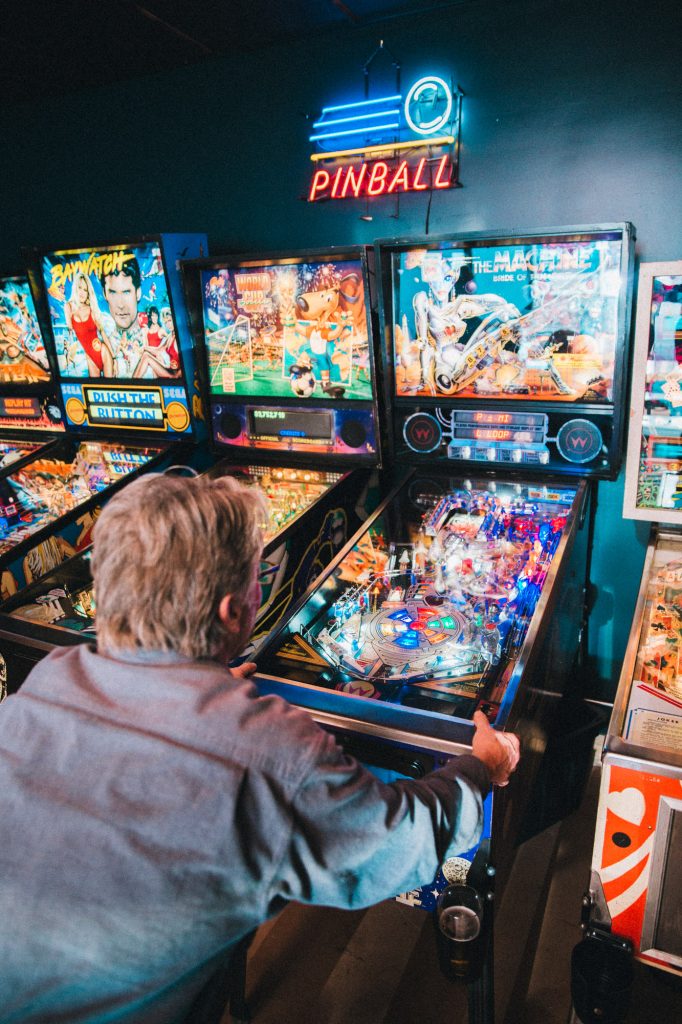
On top of the fragility of the machines, some pinballers aren’t exactly kind when they play. True, there’s a tilt mechanism to prevent egregious injury, but there’s still room for hip checks and forceful slaps of the flipper buttons. Just a little nudge can mean the difference between the dreaded drain and a continuing game. I ask the boys if the physical manipulation is critical. “I think it’s a huge part of it,” Steele answers. “And it’s one of the hardest parts as you’re starting, figuring out how to move the table and when to move the table when it matters. Your ball will drain, and you’ll be like, ‘If I’d have just moved it when it was up high, it would’ve taken a different angle. And getting that feel—it’s a huge part of it.”
“I haven’t figured it out,” Holdren deadpans. We laugh at his self-deprecation.
“When you’re watching people play, everyone has their little quirks,” continues Steele. “I have this leg kick that I do! Everybody has a little quirk.” No Quarter has rapidly drawn in fans of the game, all with different styles and varying degrees of skill. Some of their regulars are extraordinary players. After our chat, Holdren and Steele connect me to a few.
Aaron Williams is ranked within the top one thousand pinball players globally. He shares via email: “Before No Quarter opened, I played a lot at Game Galaxy in Smyrna and at Flashback Arcade in Murfreesboro. We’re really lucky to have both in the area. Game Galaxy has an amazing pinball collection of rare machines, and Flashback has really well-maintained machines. We’re pretty lucky to have a great and growing pinball scene in Middle Tennessee.”
“In the beginning, I didn’t think much of playing,” writes Cher Farnsworth. “I went to support my husband while he played in tournaments. I finally played in a tournament and it was so much fun! I would have to say, tournaments/competitive play is what makes pinball so fun and enjoyable. There is a great community of pinball players all over the world. Anytime I travel, I look to see if there is a tournament nearby that I can go to.”
Will Krusa, another No Quarter player, emails me a reminder. “With pinball, there is no winning. Eventually gravity will win out.” Spending money on a zero-sum game can be frustrating; you can measure a beginner’s game in seconds. It’s a lesson reflected in the pinball documentary Under the Glass. Ben Vigeant, founder of Pinball Chicago, smiles at the camera and agrees: “It’s an immensely frustrating thing that you’ll immediately fail at.”
Steele feels that pain. “It’s a big hurdle. When you talk to people, they’re like, ‘Oh, I’m terrible at pinball.’ Yeah. Everybody’s terrible at pinball. The point of the game is to be terrible!”
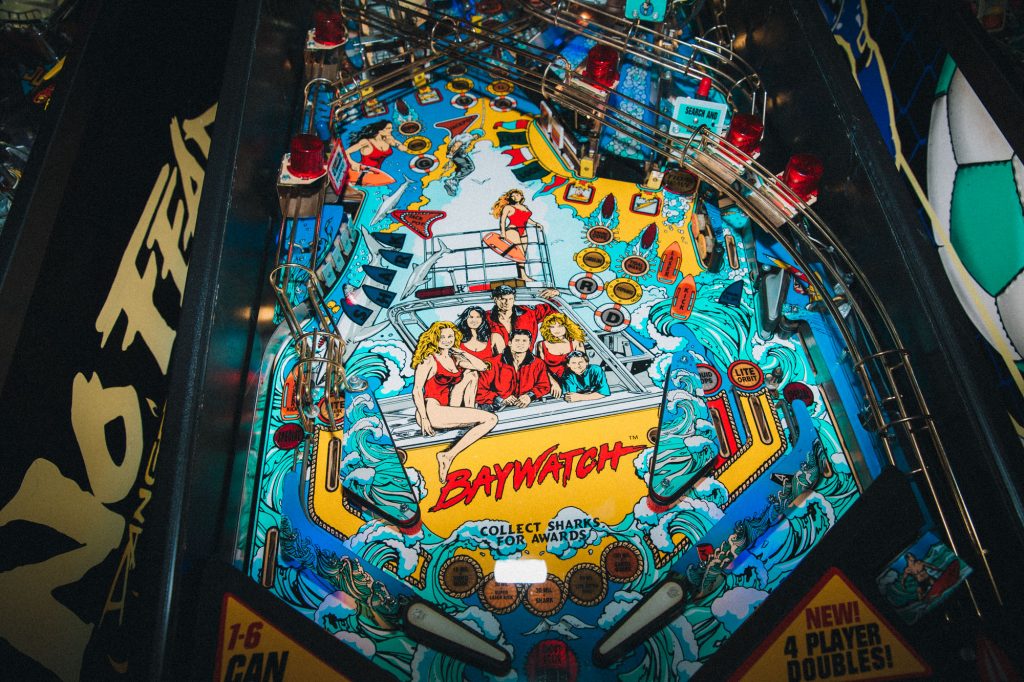
Everybody’s terrible. I come back to No Quarter for one of their weekly tournaments. I imagine my participation will end quickly. Back when I was tending bar, I’d spend slow nights pumping quarters into our Family Guy pinball machine. But that was a long time ago. Everybody’s terrible, I repeat in my mind. There’s a variety of tournament formats, each of which I’m certain I’ll lose. Tonight it’s a Strike game: lowest score on each table gets a strike; four strikes and you’re out.
The first table is Batman 66, a 2016 game that hearkens back to the campy Adam West era but uses all the newest technology, including a crystal clear video screen that plays clips from the old TV show. I come in last.
We move to Guardians of the Galaxy, another new table whose central feature is a fist-sized Groot head. “Hit him in the mouth!” someone shouts. The final bonus on my third ball barely squeezes me past Cassie Rice, Steele’s girlfriend. No strike!
All the tables going simultaneously creates a cacophonous chaos. A gunshot announces a replay. “Gamora! Look what you have done!” screams the Guardians table. An “OOGA-CHAKA OOGA-OOGA!” begins, signaling that “Hooked on a Feeling” has been unlocked. Machines from earlier eras gurgle their squawking attempts at human speech. It makes for a distracting experience—I know the serious players by the headphones they pop in before each turn.
I make it seven full rounds, but two hours in, I can’t compete with the experts. Clearly I need more practice. And more dexterity. And more quarters.
For the record, you cannot play by sense of smell. Pete Townshend is a fucking liar. Pinball lays down some heavy vibrations, but not enough to play if you can’t see. Also, fun fact: a UK music critic named Nik Cohn wasn’t a big fan of an early (pinball-less) draft of The Who’s Tommy. He was, however, a big fan of pinball. So the band turned that deaf, dumb, and blind kid into a pinball wizard. Cohn (allegedly) called the new version “a masterpiece.”
The pinball community’s response to Tommy is complicated, as Steele points out. “Some people will get upset at the idea of Tommy or ‘Pinball Wizard.’ It’s just sort of played out. But it doesn’t bother me. [There’s] sort of this weird thing with a lot of extreme pinball players where they’re just like, ‘Oh, Tommy again!’” Steele does appreciate that the music might expose folks to the game, and that’s Steele and Holdren’s goal: to get people playing pinball.
With enough quality players, Nashville could send that “trophy” back to Memphis. For now, the tiny toilet remains at No Quarter. It’s a reminder that, in the end, everything goes down the drain.
No Quarter is open Wednesday through Saturday from 4 p.m. to 12 a.m., and Sunday from 2 p.m. to 10 p.m.
Suggested Content

PHOTO RECAP: Hobo Leather Lounge
Last week we went to the Hobo Leather Lounge at White's Mercantile on 12th South. Here's what we saw.


